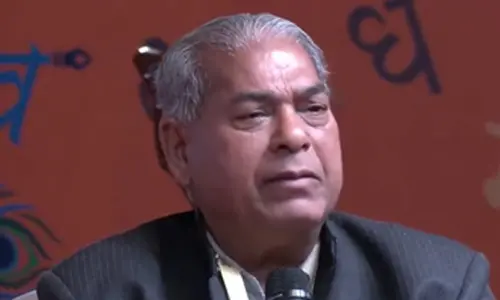India as Viksit Bharat by year 2047: A collective dream and ‘Mission’ Possible!

Focus should be on making education and health more inclusive, quality-oriented and accessible to all
Viksit Bharat @ 2047 is an opportunity for all. At every level, each of us can contribute meaningfully during the next 24 years to realize the goal of a developed India, which is more inclusive, tolerant, caring and responsible and free from the ubiquitous menace of monstrous income disparities and social atrocities.
Today our country is the fifth largest economy in the world and is projected to be the third largest by 2027 with its gross domestic product (GDP) crossing the $ 5 trillion mark. There is an encouraging estimation that India will be a $ 30 trillion economy with all attributes of a developed nation by 2047. Thus, the optimism of the dream of Viksit Bharat coming true!
A developed nation is characterized by myriad key attributes that collectively distinguish it as an advanced and prosperous entity on the global stage. Economic stability and robust infrastructure form the cornerstone of development, with a well-diversified and innovative economy driving sustained growth. High standards of living are prevalent, marked by accessible healthcare, quality education, and a social safety net that ensures the well-being of its citizens. A developed nation typically exhibits a commitment to democratic governance, rule of law and human rights, fostering a society that values equality, justice and individual freedom.
Moreover, technological prowess and a culture of innovation are evident, since a developed nation leads in research and development, constantly pushing the boundaries of scientific discovery. Environmental sustainability becomes a priority, with eco-friendly policies aimed at preserving natural resources and mitigating the impact of industrialization on the planet. A developed nation boasts of efficient public services, a low level of corruption and a vibrant legal framework, creating an environment conducive to entrepreneurship and a thriving business ecosystem. Thus, a developed nation should epitomize economic prosperity, social well-being, environmental responsibility, technological advancement and a commitment to democratic values.
The task is certainly not a kind of mission impossible but one which is in the realm of possibilities, provided each of us plays our role with honesty and an unwavering commitment to the ideas and ideals of socio-economic justice and inclusivity.
These were the values which helped Japan, Germany, Singapore, South Korea, and even China to transform their turning points into an opportunity to become economic giants. They rose to the occasion in a fashion, overcame odds, set aside discriminatory policies and embraced total inclusivity. They focussed on education, health, infrastructure and justice. It took them less than 30 years to leapfrog to the club of developed nations. Their investment in human capital proved a turning point and today they are role models of inclusive economic growth for the rest of the world.
Since Independence in 1947, India has transformed in many fields. The pace of progress and multifaceted metamorphosis continues. Yet we need to be more focussed on making education and health more inclusive, quality-oriented, competitive and accessible to all. India is blessed with nearly 600 million people aged between 18 and 35 years but only around 4.33 crore of them are enrolled in colleges and universities as students, putting the gross enrolment ratio (GER) to 28.4 per cent.
The share of students from OBC, SC and ST communities in higher education is much less. Therefore, we need to increase their GER not only in public sector institutions but also those in the private sector by enforcing affirmative measures in totality to achieve the 50 per cent GER target by 2035.
Accordingly, we need to enhance GER in school education. However, under no circumstances the quality of education should be compromised. The option of ‘one nation, one education, one curriculum, one board and a uniform fee’ must be explored seriously so far as school education is concerned. Equally important is imparting quality skill and medical education to our students across the country. A strategy should be evolved to ensure that every secondary and higher secondary school has a proper laboratory to impart skill training to aspiring children in sync with the spirit of new National Education Policy-2020.
Similarly, every district hospital should start a full-fledged course to create qualified physicians, who will play an important role in preventing lifestyle diseases, which are going to be a matter of serious concern for us by 2035.
Similarly, health is an area India needs to focus on with all commitment. Since poverty is a principal cause of multiple ailments masses suffer from, efforts must be made to make affordable, quality and accessible healthcare a pan India reality in general and in rural areas in particular. With more than 70 per cent of the population living in rural areas and low levels of health facilities, mortality rates due to diseases are on a high. Lack of quality infrastructure, dearth of qualified medical functionaries, and non-access to basic medicines and medical facilities deprive majority of rural people of timely interventions.
The overall condition of most primary health centres (PHCs) and community health centres (CHCs) is not up to the mark if not deplorable. There is a dire need for evolving new practices, procedures and more investments to ensure that quality and timely healthcare reaches the deprived corners of villages. Though a lot of policies and programs are being run by the governments, the gaps remain monstrous. Nothing less than colossal efforts will be required to ensure inclusivity in the distribution of job opportunities in public and private sectors among the people irrespective of their social identities and areas of habitation.
The rural-urban divide, rich-poor divide, backward and forward divide, upper caste and lower caste divide – India is plagued with a slew of divisions, denials and deprivations, which need to be addressed not only to safeguard and sustain our diversity as a nation but also to strengthen our socio-economic fabric for sustainable development. Equitable distribution of socio-economic opportunities should be non-negotiable for an inclusive society. In such a society, every individual, regardless of their background, should have fair and equal access to education, employment, healthcare, and other essential resources. We must embrace policies that promote equal access and dismantle systemic barriers for a more just and harmonious society, where the collective prosperity of the masses becomes the driving force for sustainable development and a brighter future for all.
India @ 2047 must be happier, healthier, inclusive and full of compassion and empathy!
















